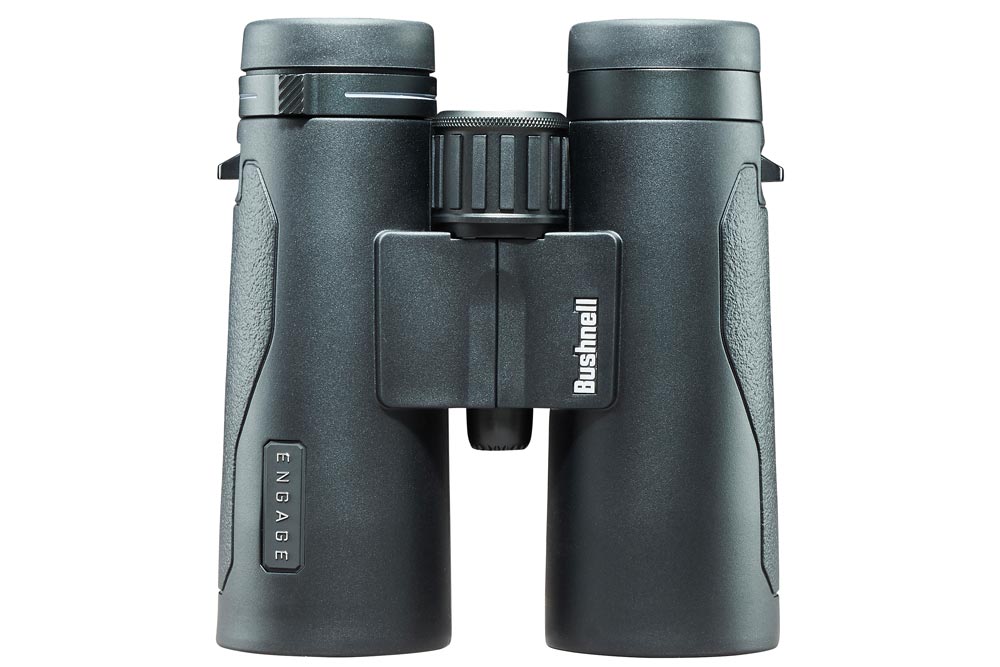Bushnell Engage EDX 8x42 binocular
American optics brand Bushnell has launched what may prove to be the company's best binoculars to date: the EDX Engage series. Said to already have become a bestseller, and with a price among the highest in the company's largely entry-level range, the 8x42 uses Bushnell's highest-quality 'ED Prime' fluorite glass to deliver images to a new, higher standard.
The binocular as a whole feels solid, compact and relatively light in weight, the magnesium chassis being wrapped in smooth rubber, apart from a textured, non-slip area that is in contact with the proximal phalanx of each finger. This area, which runs almost the full length of the chassis, is cleverly shaped to reflect the positioning of the area of the fingers and that of the palm of your hand in contact with the binocular when being held. In addition to this 'grippy' expanse, there are smooth, shallow thumb rests.
The strap lugs are positioned opposite the middle of the central focusing wheel, but are semi-recessed so as to be less obtrusive when holding and operating the binocular. A narrow, stipple-edged front disc caps the broadly milled, rubber-covered focusing wheel. The latter is little more than a finger's width and turns smoothly and easily, with approximately 1.5 anticlockwise rotations between close focus and infinity. I measured the close focus distance of the test model as approximately 1.8 m, beating the brand's quoted figure of 2 m.

The focusing operation is pretty slick, with just shy of a quarter of a turn taking the image in focus from approximately 10 m to around 500 m.
For single-eye focusing, the dioptre ring is located on the right ocular and has a small, raised flange, which is used to turn the ring after first pulling it upwards, turning it to the desired setting and pushing it down again to lock it firmly in place. It is designed with a narrow space between it and the eyecup and it is not necessary to twist the latter out in order to change the setting.
In terms of eyecup height adjustment, there are three twist-out, narrowly separated click-stops above the base setting. I was pleased to be able to see the full field of view, regardless of which height position the eyecups were set in. This was no doubt a function of the distance between the twist-out settings being among the shortest I have ever encountered. The rubber coverings of the eyecups were what I would describe as 'medium soft' and bevelled and I found them pleasantly comfortable against the eye.
Bushnell's latest EXO Barrier Protection coating – said to be the best protective lens coating technology the company has ever developed – has been applied to external glass surfaces to repel water, debris, oil and fog, as well as helping to prevent scratches.
The lenses themselves are fully multi-coated, the multiple layers of anti-reflective coating serving to increase light transmission. PC3 phase coating has been applied to the prisms to enhance resolution and contrast, while a dielectric prism coating further increases light transmission. All glass elements used in the binocular are environmentally friendly lead-free.
So, how does all this translate to performance in the field? In general, I found the Engage EDX to be well balanced, comfortable to hold and easy to operate.
Accurate colour reproduction is something I place significant importance on and this binocular has it. One of the easiest ways of checking this is to look at areas of Phragmites and to try to determine if the colour in the image matches the actual colour of the reeds. In many low-priced models across the binocularscape, their pale straw colour is not accurately reflected and the image, to my eyes, takes on an artificially brownish hue.
An element of this is down to brightness and at 92% light transmission, this helps to 'lift' colour. In the subdued lighting of woodland, under the tree canopy, the EDX was still quite bright, but not quite up to the level of high-end binoculars with a similar specification, which were used in a side-by-side comparison. Image contrast is particularly good and sharpness stretches almost to the edge of the field, where I would say there is 'average' curvature.
The 'ED Prime' fluorite glass is said to “virtually eliminate chromatic aberration and colour fringing". However, it is still obviously present in the image, at a level I would have expected to see in binoculars in this price range, although it doesn't detract from everyday standard viewing.
As far as accessories are concerned, the Engage EDX comes with removable, tethered objective lens caps that push into the objective housing, although they are prone to coming out quite quickly and easily. Their slide-over loop fitting is secure, tight and the caps did not become untethered in the field. The ocular end is covered by an articulated rainguard which is soft, flexible and fits perfectly so as not to alter eyecup positioning when put in place and removed. A comfortable lanyard is supplied and a soft – though not padded – carry case completes the package.
I would conclude this is probably Bushnell's best birding binocular to date.
Further info
- Price: £440
- Size: 140x119 mm
- Weight: 666 g
- Field of view: 142 m at 1,000 m
- Light transmission: 92%
- Close focus: 2 m
- Gas-filled: yes
- Waterproof: yes
- Guarantee: 20 years
Verdict
+ Contrast is particularly good
+ Sharp almost to edge of field
- Some chromatic aberratiion visible


